Exploring Social Determinants of Lung Cancer: An Australian Study
VerifiedAdded on 2023/04/08
|6
|1064
|384
Essay
AI Summary
This essay examines the social determinants of lung cancer in Australia, highlighting the significant impact of factors such as low socio-demographic status, physical environment, and health literacy. Smoking, heavily influenced by unemployment and psychological distress, is identified as a major cause. The essay discusses how low socio-economic status affects access to healthcare and exacerbates the disease's progress. It also addresses the role of peer influence and parental smoking habits in adolescents, along with workplace exposures for adults. Inadequate health literacy, particularly in indigenous communities, further contributes to the problem. The essay concludes by emphasizing the need for interventions like employment opportunities, counseling, workplace policies, and health promotion campaigns to reduce lung cancer prevalence in Australia. Desklib provides access to similar essays and study tools for students.
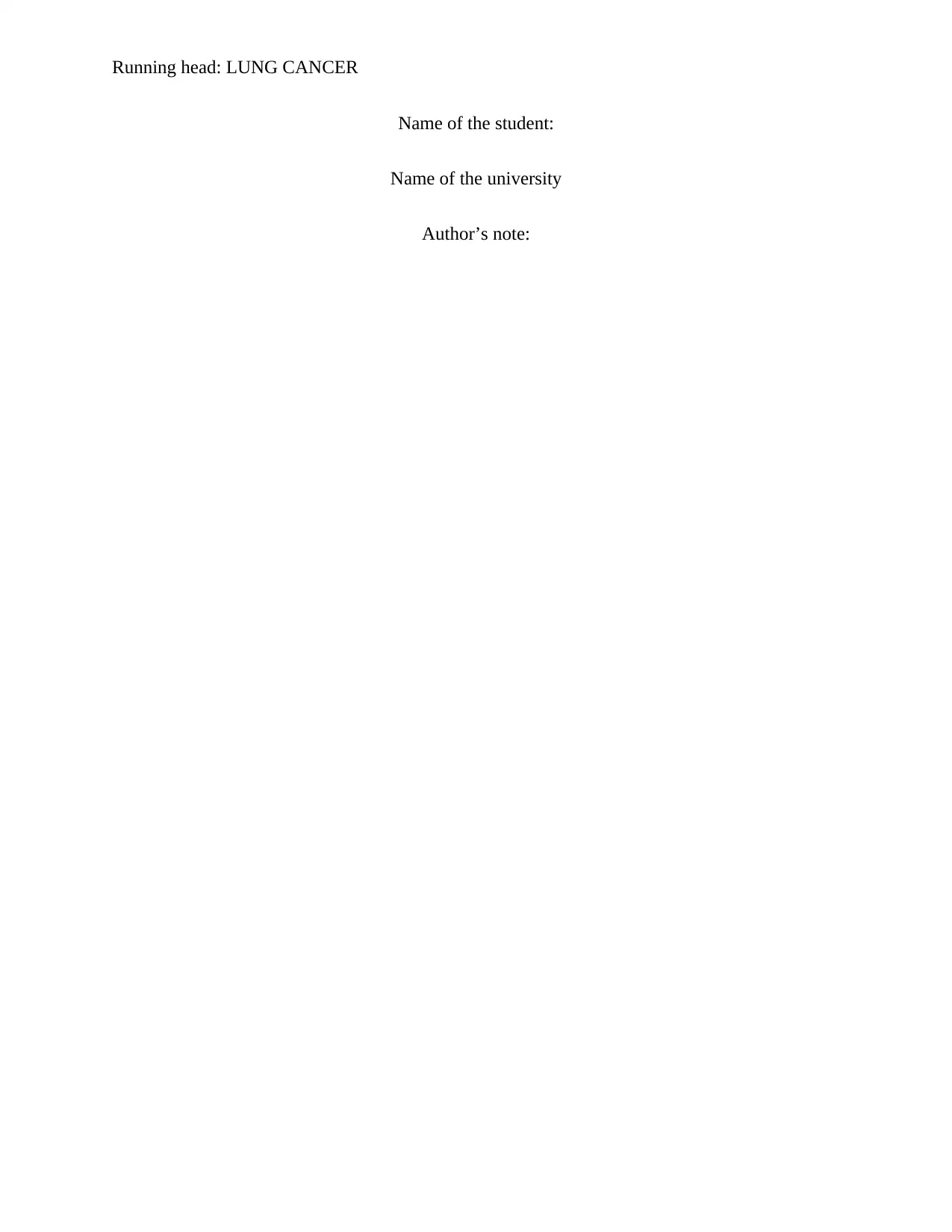
Running head: LUNG CANCER
Name of the student:
Name of the university
Author’s note:
Name of the student:
Name of the university
Author’s note:
Paraphrase This Document
Need a fresh take? Get an instant paraphrase of this document with our AI Paraphraser
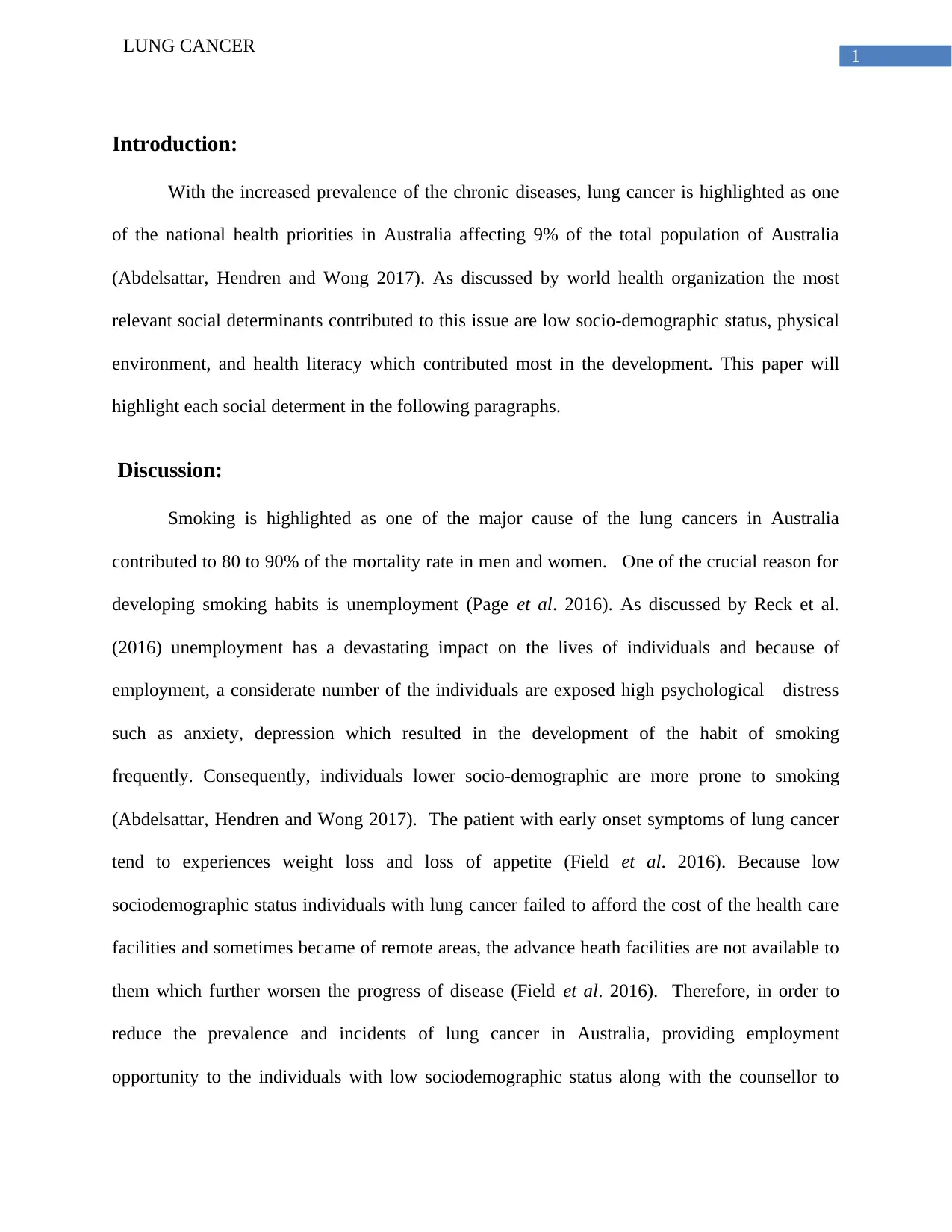
1
LUNG CANCER
Introduction:
With the increased prevalence of the chronic diseases, lung cancer is highlighted as one
of the national health priorities in Australia affecting 9% of the total population of Australia
(Abdelsattar, Hendren and Wong 2017). As discussed by world health organization the most
relevant social determinants contributed to this issue are low socio-demographic status, physical
environment, and health literacy which contributed most in the development. This paper will
highlight each social determent in the following paragraphs.
Discussion:
Smoking is highlighted as one of the major cause of the lung cancers in Australia
contributed to 80 to 90% of the mortality rate in men and women. One of the crucial reason for
developing smoking habits is unemployment (Page et al. 2016). As discussed by Reck et al.
(2016) unemployment has a devastating impact on the lives of individuals and because of
employment, a considerate number of the individuals are exposed high psychological distress
such as anxiety, depression which resulted in the development of the habit of smoking
frequently. Consequently, individuals lower socio-demographic are more prone to smoking
(Abdelsattar, Hendren and Wong 2017). The patient with early onset symptoms of lung cancer
tend to experiences weight loss and loss of appetite (Field et al. 2016). Because low
sociodemographic status individuals with lung cancer failed to afford the cost of the health care
facilities and sometimes became of remote areas, the advance heath facilities are not available to
them which further worsen the progress of disease (Field et al. 2016). Therefore, in order to
reduce the prevalence and incidents of lung cancer in Australia, providing employment
opportunity to the individuals with low sociodemographic status along with the counsellor to
LUNG CANCER
Introduction:
With the increased prevalence of the chronic diseases, lung cancer is highlighted as one
of the national health priorities in Australia affecting 9% of the total population of Australia
(Abdelsattar, Hendren and Wong 2017). As discussed by world health organization the most
relevant social determinants contributed to this issue are low socio-demographic status, physical
environment, and health literacy which contributed most in the development. This paper will
highlight each social determent in the following paragraphs.
Discussion:
Smoking is highlighted as one of the major cause of the lung cancers in Australia
contributed to 80 to 90% of the mortality rate in men and women. One of the crucial reason for
developing smoking habits is unemployment (Page et al. 2016). As discussed by Reck et al.
(2016) unemployment has a devastating impact on the lives of individuals and because of
employment, a considerate number of the individuals are exposed high psychological distress
such as anxiety, depression which resulted in the development of the habit of smoking
frequently. Consequently, individuals lower socio-demographic are more prone to smoking
(Abdelsattar, Hendren and Wong 2017). The patient with early onset symptoms of lung cancer
tend to experiences weight loss and loss of appetite (Field et al. 2016). Because low
sociodemographic status individuals with lung cancer failed to afford the cost of the health care
facilities and sometimes became of remote areas, the advance heath facilities are not available to
them which further worsen the progress of disease (Field et al. 2016). Therefore, in order to
reduce the prevalence and incidents of lung cancer in Australia, providing employment
opportunity to the individuals with low sociodemographic status along with the counsellor to
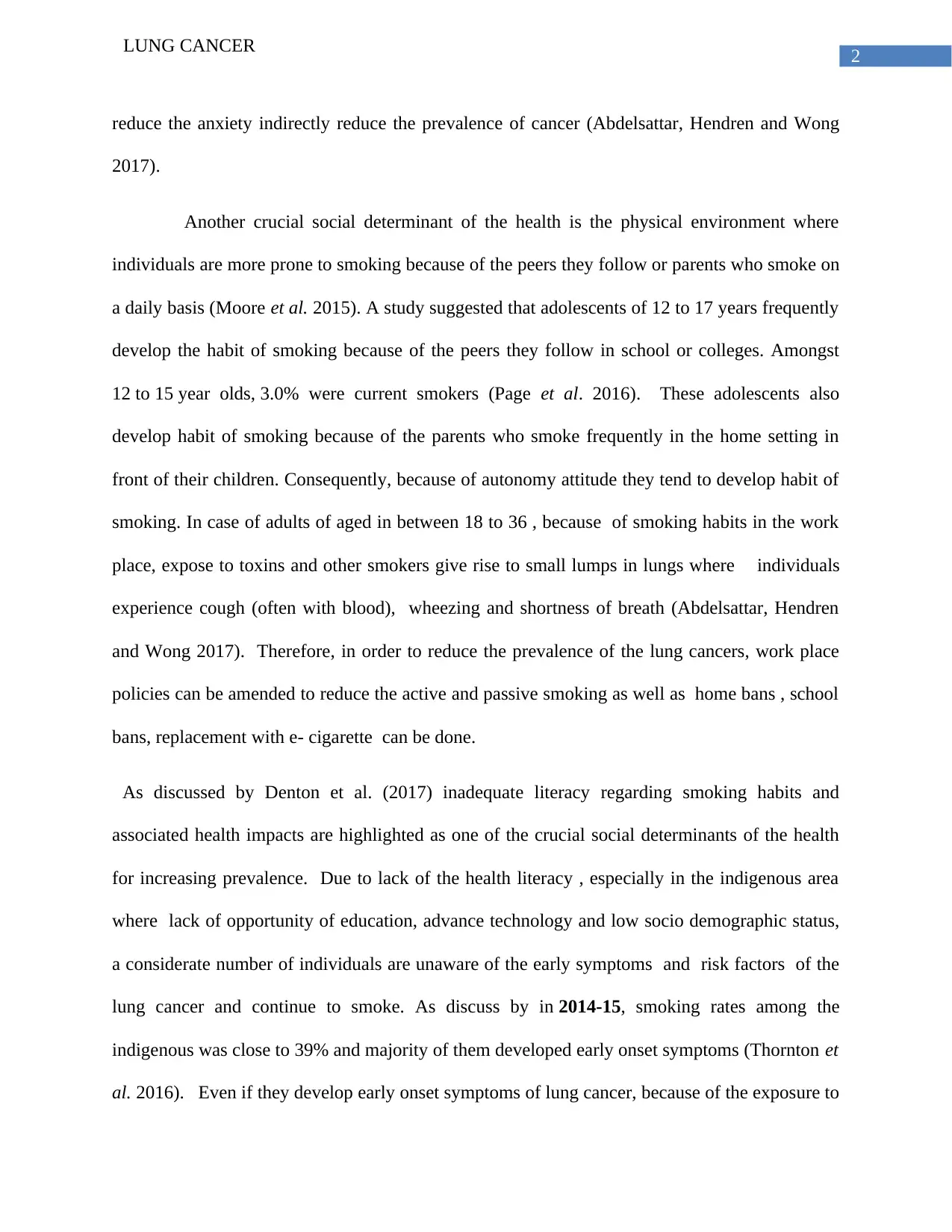
2
LUNG CANCER
reduce the anxiety indirectly reduce the prevalence of cancer (Abdelsattar, Hendren and Wong
2017).
Another crucial social determinant of the health is the physical environment where
individuals are more prone to smoking because of the peers they follow or parents who smoke on
a daily basis (Moore et al. 2015). A study suggested that adolescents of 12 to 17 years frequently
develop the habit of smoking because of the peers they follow in school or colleges. Amongst
12 to 15 year olds, 3.0% were current smokers (Page et al. 2016). These adolescents also
develop habit of smoking because of the parents who smoke frequently in the home setting in
front of their children. Consequently, because of autonomy attitude they tend to develop habit of
smoking. In case of adults of aged in between 18 to 36 , because of smoking habits in the work
place, expose to toxins and other smokers give rise to small lumps in lungs where individuals
experience cough (often with blood), wheezing and shortness of breath (Abdelsattar, Hendren
and Wong 2017). Therefore, in order to reduce the prevalence of the lung cancers, work place
policies can be amended to reduce the active and passive smoking as well as home bans , school
bans, replacement with e- cigarette can be done.
As discussed by Denton et al. (2017) inadequate literacy regarding smoking habits and
associated health impacts are highlighted as one of the crucial social determinants of the health
for increasing prevalence. Due to lack of the health literacy , especially in the indigenous area
where lack of opportunity of education, advance technology and low socio demographic status,
a considerate number of individuals are unaware of the early symptoms and risk factors of the
lung cancer and continue to smoke. As discuss by in 2014-15, smoking rates among the
indigenous was close to 39% and majority of them developed early onset symptoms (Thornton et
al. 2016). Even if they develop early onset symptoms of lung cancer, because of the exposure to
LUNG CANCER
reduce the anxiety indirectly reduce the prevalence of cancer (Abdelsattar, Hendren and Wong
2017).
Another crucial social determinant of the health is the physical environment where
individuals are more prone to smoking because of the peers they follow or parents who smoke on
a daily basis (Moore et al. 2015). A study suggested that adolescents of 12 to 17 years frequently
develop the habit of smoking because of the peers they follow in school or colleges. Amongst
12 to 15 year olds, 3.0% were current smokers (Page et al. 2016). These adolescents also
develop habit of smoking because of the parents who smoke frequently in the home setting in
front of their children. Consequently, because of autonomy attitude they tend to develop habit of
smoking. In case of adults of aged in between 18 to 36 , because of smoking habits in the work
place, expose to toxins and other smokers give rise to small lumps in lungs where individuals
experience cough (often with blood), wheezing and shortness of breath (Abdelsattar, Hendren
and Wong 2017). Therefore, in order to reduce the prevalence of the lung cancers, work place
policies can be amended to reduce the active and passive smoking as well as home bans , school
bans, replacement with e- cigarette can be done.
As discussed by Denton et al. (2017) inadequate literacy regarding smoking habits and
associated health impacts are highlighted as one of the crucial social determinants of the health
for increasing prevalence. Due to lack of the health literacy , especially in the indigenous area
where lack of opportunity of education, advance technology and low socio demographic status,
a considerate number of individuals are unaware of the early symptoms and risk factors of the
lung cancer and continue to smoke. As discuss by in 2014-15, smoking rates among the
indigenous was close to 39% and majority of them developed early onset symptoms (Thornton et
al. 2016). Even if they develop early onset symptoms of lung cancer, because of the exposure to
⊘ This is a preview!⊘
Do you want full access?
Subscribe today to unlock all pages.

Trusted by 1+ million students worldwide
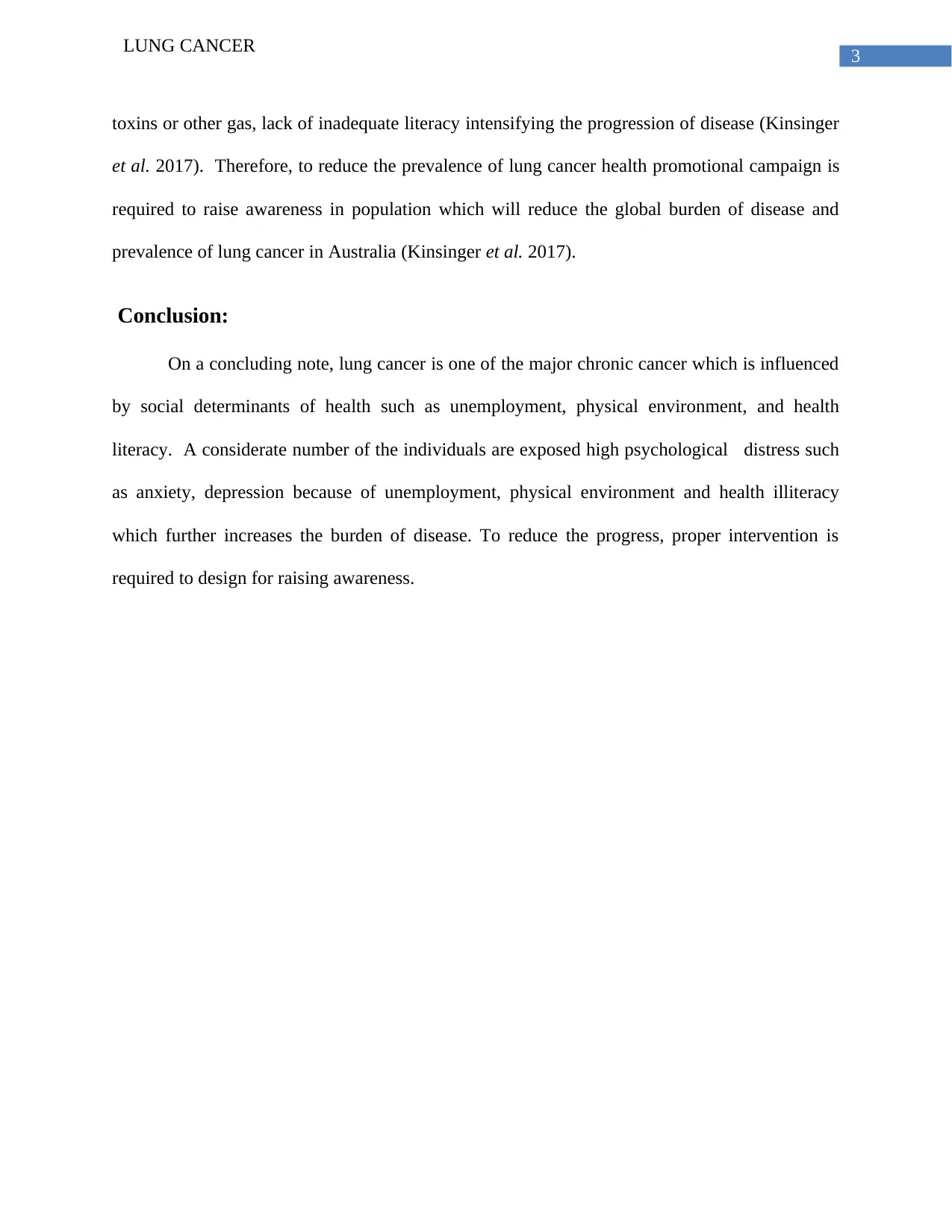
3
LUNG CANCER
toxins or other gas, lack of inadequate literacy intensifying the progression of disease (Kinsinger
et al. 2017). Therefore, to reduce the prevalence of lung cancer health promotional campaign is
required to raise awareness in population which will reduce the global burden of disease and
prevalence of lung cancer in Australia (Kinsinger et al. 2017).
Conclusion:
On a concluding note, lung cancer is one of the major chronic cancer which is influenced
by social determinants of health such as unemployment, physical environment, and health
literacy. A considerate number of the individuals are exposed high psychological distress such
as anxiety, depression because of unemployment, physical environment and health illiteracy
which further increases the burden of disease. To reduce the progress, proper intervention is
required to design for raising awareness.
LUNG CANCER
toxins or other gas, lack of inadequate literacy intensifying the progression of disease (Kinsinger
et al. 2017). Therefore, to reduce the prevalence of lung cancer health promotional campaign is
required to raise awareness in population which will reduce the global burden of disease and
prevalence of lung cancer in Australia (Kinsinger et al. 2017).
Conclusion:
On a concluding note, lung cancer is one of the major chronic cancer which is influenced
by social determinants of health such as unemployment, physical environment, and health
literacy. A considerate number of the individuals are exposed high psychological distress such
as anxiety, depression because of unemployment, physical environment and health illiteracy
which further increases the burden of disease. To reduce the progress, proper intervention is
required to design for raising awareness.
Paraphrase This Document
Need a fresh take? Get an instant paraphrase of this document with our AI Paraphraser
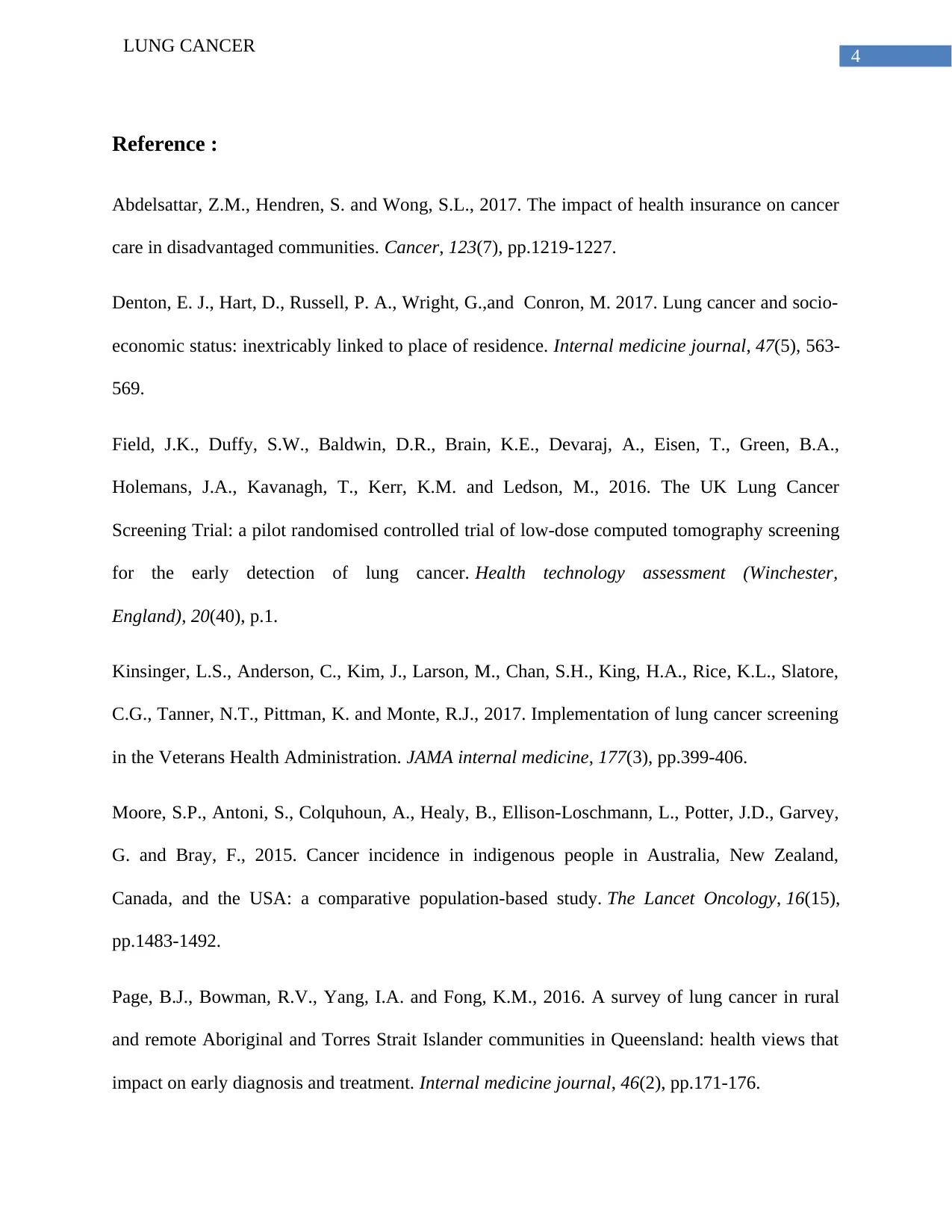
4
LUNG CANCER
Reference :
Abdelsattar, Z.M., Hendren, S. and Wong, S.L., 2017. The impact of health insurance on cancer
care in disadvantaged communities. Cancer, 123(7), pp.1219-1227.
Denton, E. J., Hart, D., Russell, P. A., Wright, G.,and Conron, M. 2017. Lung cancer and socio‐
economic status: inextricably linked to place of residence. Internal medicine journal, 47(5), 563-
569.
Field, J.K., Duffy, S.W., Baldwin, D.R., Brain, K.E., Devaraj, A., Eisen, T., Green, B.A.,
Holemans, J.A., Kavanagh, T., Kerr, K.M. and Ledson, M., 2016. The UK Lung Cancer
Screening Trial: a pilot randomised controlled trial of low-dose computed tomography screening
for the early detection of lung cancer. Health technology assessment (Winchester,
England), 20(40), p.1.
Kinsinger, L.S., Anderson, C., Kim, J., Larson, M., Chan, S.H., King, H.A., Rice, K.L., Slatore,
C.G., Tanner, N.T., Pittman, K. and Monte, R.J., 2017. Implementation of lung cancer screening
in the Veterans Health Administration. JAMA internal medicine, 177(3), pp.399-406.
Moore, S.P., Antoni, S., Colquhoun, A., Healy, B., Ellison-Loschmann, L., Potter, J.D., Garvey,
G. and Bray, F., 2015. Cancer incidence in indigenous people in Australia, New Zealand,
Canada, and the USA: a comparative population-based study. The Lancet Oncology, 16(15),
pp.1483-1492.
Page, B.J., Bowman, R.V., Yang, I.A. and Fong, K.M., 2016. A survey of lung cancer in rural
and remote Aboriginal and Torres Strait Islander communities in Queensland: health views that
impact on early diagnosis and treatment. Internal medicine journal, 46(2), pp.171-176.
LUNG CANCER
Reference :
Abdelsattar, Z.M., Hendren, S. and Wong, S.L., 2017. The impact of health insurance on cancer
care in disadvantaged communities. Cancer, 123(7), pp.1219-1227.
Denton, E. J., Hart, D., Russell, P. A., Wright, G.,and Conron, M. 2017. Lung cancer and socio‐
economic status: inextricably linked to place of residence. Internal medicine journal, 47(5), 563-
569.
Field, J.K., Duffy, S.W., Baldwin, D.R., Brain, K.E., Devaraj, A., Eisen, T., Green, B.A.,
Holemans, J.A., Kavanagh, T., Kerr, K.M. and Ledson, M., 2016. The UK Lung Cancer
Screening Trial: a pilot randomised controlled trial of low-dose computed tomography screening
for the early detection of lung cancer. Health technology assessment (Winchester,
England), 20(40), p.1.
Kinsinger, L.S., Anderson, C., Kim, J., Larson, M., Chan, S.H., King, H.A., Rice, K.L., Slatore,
C.G., Tanner, N.T., Pittman, K. and Monte, R.J., 2017. Implementation of lung cancer screening
in the Veterans Health Administration. JAMA internal medicine, 177(3), pp.399-406.
Moore, S.P., Antoni, S., Colquhoun, A., Healy, B., Ellison-Loschmann, L., Potter, J.D., Garvey,
G. and Bray, F., 2015. Cancer incidence in indigenous people in Australia, New Zealand,
Canada, and the USA: a comparative population-based study. The Lancet Oncology, 16(15),
pp.1483-1492.
Page, B.J., Bowman, R.V., Yang, I.A. and Fong, K.M., 2016. A survey of lung cancer in rural
and remote Aboriginal and Torres Strait Islander communities in Queensland: health views that
impact on early diagnosis and treatment. Internal medicine journal, 46(2), pp.171-176.
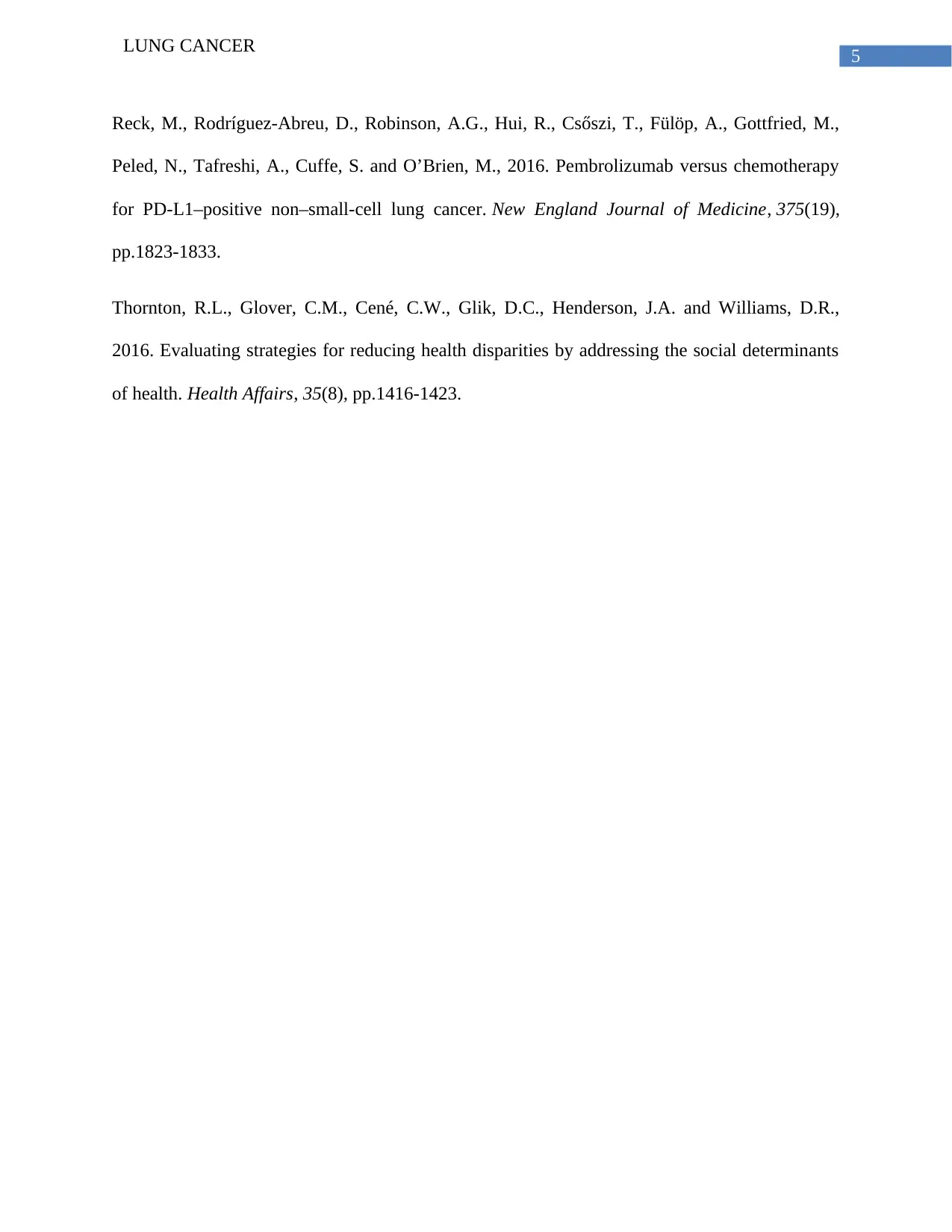
5
LUNG CANCER
Reck, M., Rodríguez-Abreu, D., Robinson, A.G., Hui, R., Csőszi, T., Fülöp, A., Gottfried, M.,
Peled, N., Tafreshi, A., Cuffe, S. and O’Brien, M., 2016. Pembrolizumab versus chemotherapy
for PD-L1–positive non–small-cell lung cancer. New England Journal of Medicine, 375(19),
pp.1823-1833.
Thornton, R.L., Glover, C.M., Cené, C.W., Glik, D.C., Henderson, J.A. and Williams, D.R.,
2016. Evaluating strategies for reducing health disparities by addressing the social determinants
of health. Health Affairs, 35(8), pp.1416-1423.
LUNG CANCER
Reck, M., Rodríguez-Abreu, D., Robinson, A.G., Hui, R., Csőszi, T., Fülöp, A., Gottfried, M.,
Peled, N., Tafreshi, A., Cuffe, S. and O’Brien, M., 2016. Pembrolizumab versus chemotherapy
for PD-L1–positive non–small-cell lung cancer. New England Journal of Medicine, 375(19),
pp.1823-1833.
Thornton, R.L., Glover, C.M., Cené, C.W., Glik, D.C., Henderson, J.A. and Williams, D.R.,
2016. Evaluating strategies for reducing health disparities by addressing the social determinants
of health. Health Affairs, 35(8), pp.1416-1423.
⊘ This is a preview!⊘
Do you want full access?
Subscribe today to unlock all pages.

Trusted by 1+ million students worldwide
1 out of 6
Related Documents
Your All-in-One AI-Powered Toolkit for Academic Success.
+13062052269
info@desklib.com
Available 24*7 on WhatsApp / Email
![[object Object]](/_next/static/media/star-bottom.7253800d.svg)
Unlock your academic potential
Copyright © 2020–2025 A2Z Services. All Rights Reserved. Developed and managed by ZUCOL.





